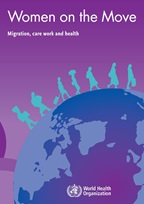
Module 3
Tackling the social determinants of health and workers' and occupational health and safety

Tool 12: Workers’ and occupational health and safety
Tool overview
The International Labour Organization (ILO) estimated that there were 169 million migrant workers worldwide in 2021; 58% are men (99 million men and 70 million women) and most find work in service industries, followed by manufacturing; these employ almost two in three migrants, while 7% work in agriculture. More than two in three migrant workers are concentrated in high-income countries. Substantial gender differences exist between the sectors, with a higher number of women migrant workers in services, including health and domestic work. This may be partly explained by a growing labour demand for care workers while manufacturing remains dominated by men.
Health risks at the workplace, such as heat, noise, dust, hazardous chemicals, unsafe machines and psychological stress, cause occupational diseases and can aggravate other health problems. Conditions of employment, occupation and the position in the workplace hierarchy also affect health. People working under stress or with precarious employment conditions are likely to smoke more, exercise less and have an unhealthy diet. In addition to general health care, all workers – and particularly those in high-risk occupations – need health services to assess and reduce exposure to occupational risks, as well as medical surveillance for early detection of occupational and work-related diseases and injuries.
NCDs related to working conditions and to occupational stress result in increasing rates of long-term illness and absence from work. Occupational NCDs include occupation-related cancers, chronic bronchitis and asthma caused by pollution in the workplace, and radiation. Chronic respiratory diseases, musculoskeletal disorders, noise-induced hearing loss and skin problems are the most common occupational diseases. Yet only one third of countries have programmes in place to address these issues.
Despite these diseases, in the majority of countries health workers are not adequately trained to address work-related health problems and many countries do not offer postgraduate education in occupational health. The COVID-19 crisis has intensified these vulnerabilities, particularly for female migrant workers, as they are overrepresented in low-paid and low-skilled jobs and may have limited access to health services and social protection and fewer options for support services. WHO has a number of guidelines and fact sheets on occupational health.
Global plan of action on workers' health
World Health Assembly resolution WHA60.26, Workers’ Health: Global Plan of Action, urged Member States “to work towards full coverage of all workers, particularly those in the informal sector, agriculture, small enterprises and migrant workers with essential interventions and basic occupational health services for primary prevention of occupational and work-related diseases and injuries".
WHO’s proposed strategy to improve health coverage of workers, including those working in small companies and the informal sector, is to work with countries in the following strategic directions.
- Increase skills of primary care providers (general practitioners, nurses, environmental and public health technicians, and community health workers) to provide basic occupational health services such as advice on improving working conditions, monitoring the health status of workers and detecting the most common occupational diseases among workers in small companies, rural areas, farms, the informal sector and among migrants.
- Expand the coverage and improve the quality of specialized occupational health services in big and medium-sized companies and industrial zones, with a focus on assessing and reducing occupational risks; surveillance and improvement of the work environment, work organization, machinery and equipment; early detection and rehabilitation of occupational diseases; promotion of health; and the provision of first aid at the workplace.
- Establish connections between occupational health services and primary care centres to facilitate the care of workers suffering from chronic diseases and their return to work after long-term absence due to sickness.
- Develop workplace health initiatives, tools and methods for empowering companies and other work settings to take better care of health without unduly relying on professional health services.
- Include occupational health in the pre- and in-service training of all frontline health providers and certain medical specialists dealing with cancer; skin, respiratory and neurological diseases; and musculoskeletal disorders.
- Develop roadmaps for scaling up access of workers to essential interventions and services, as defined nationally, for prevention and control of occupational and work-related diseases, including monitoring coverage and setting realistic targets in line with available human and financial resources for health and local traditions.
Key international labour standards
C97. Migration for Employment Convention (Revised), 1949 (No. 97)
C143. Migrant Workers (Supplementary Provisions) Convention, 1975 (No. 143)
C155.Occupational Safety and Health Convention, 1981 (No. 155)
R164. Occupational Safety and Health Recommendation, 1981 (No. 164)
C187.Promotional Framework for Occupational Safety and Health Convention, 2006 (No. 187)
R197. Promotional Framework for Occupational Safety and Health Recommendation, 2006 (No. 197)
Guidance and tools
Workers' and occupational health and safety
Guidance, training, reports

Occupational safety and health in public health emergencies: a manual for protecting health workers and...
This manual provides an overview of the main OSH risks faced by emergency responders during disease outbreaks and other emergencies, such as natural disasters,...
Preventing disease through a healthier and safer workspace
This comprehensive global assessment provides insights on the health impacts that could be avoided through healthier and safer workplaces. It is estimated...
Caring for those who care: national programmes for occupational health for health workers: policy brief
Health is a universal human right and a main contributor to well-being, economic development, growth, wealth and prosperity for all. Health systems play...

Women on the move: migration, care work and health
In so many homes and places around the world, women of all ages, ethnicities, cultures and backgrounds are providing essential care to others, within and...
Tools
Protection of health and safety of health workers: checklist for healthcare facilities
This checklist is the first step in identifying and prioritizing areas of action for improving the protection of health and safety of health workers in...
